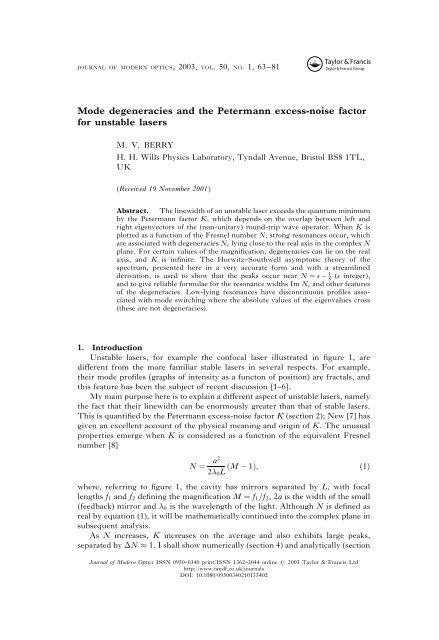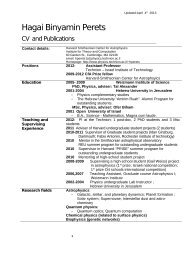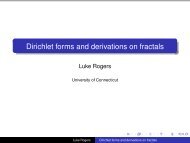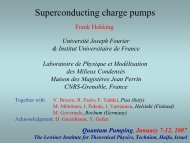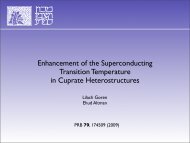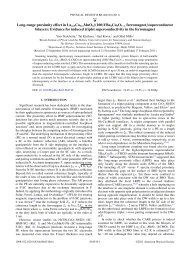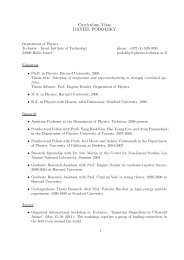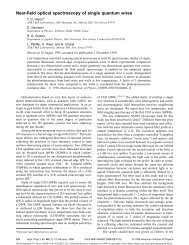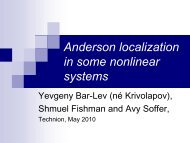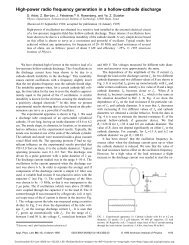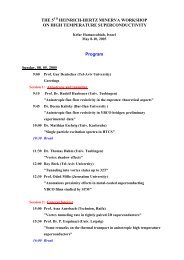Mode degeneracies and the Petermann excess-noise factor for ...
Mode degeneracies and the Petermann excess-noise factor for ...
Mode degeneracies and the Petermann excess-noise factor for ...
You also want an ePaper? Increase the reach of your titles
YUMPU automatically turns print PDFs into web optimized ePapers that Google loves.
journal of modern optics, 2003, vol. 50, no. 1, 63–81<br />
<strong>Mode</strong> <strong>degeneracies</strong> <strong>and</strong> <strong>the</strong> <strong>Petermann</strong> <strong>excess</strong>-<strong>noise</strong> <strong>factor</strong><br />
<strong>for</strong> unstable lasers<br />
M. V. BERRY<br />
H. H. Wills Physics Laboratory, Tyndall Avenue, Bristol BS81TL,<br />
UK<br />
(Received 19 November 2001)<br />
Abstract. The linewidth of an unstable laser exceeds <strong>the</strong> quantum minimum<br />
by <strong>the</strong> <strong>Petermann</strong> <strong>factor</strong> K, which depends on <strong>the</strong> overlap between left <strong>and</strong><br />
right eigenvectors of <strong>the</strong> (non-unitary) round-trip wave operator. When K is<br />
plotted as a function of <strong>the</strong> Fresnel number N, strong resonances occur, which<br />
are associated with <strong>degeneracies</strong> Nc lying close to <strong>the</strong> real axis in <strong>the</strong> complex N<br />
plane. For certain values of <strong>the</strong> magnification, <strong>degeneracies</strong> can lie on <strong>the</strong> real<br />
axis, <strong>and</strong> K is infinite. The Horwitz–Southwell asymptotic <strong>the</strong>ory of <strong>the</strong><br />
spectrum, presented here in a very accurate <strong>for</strong>m <strong>and</strong> with a streamlined<br />
1<br />
derivation, is used to show that <strong>the</strong> peaks occur near N ¼ s 8 (s integer),<br />
<strong>and</strong> to give reliable <strong>for</strong>mulae <strong>for</strong> <strong>the</strong> resonance widths Im Nc <strong>and</strong> o<strong>the</strong>r features<br />
of <strong>the</strong> <strong>degeneracies</strong>. Low-lying resonances have discontinuous profiles associated<br />
with mode switching where <strong>the</strong> absolute values of <strong>the</strong> eigenvalues cross<br />
(<strong>the</strong>se are not <strong>degeneracies</strong>).<br />
1. Introduction<br />
Unstable lasers, <strong>for</strong> example <strong>the</strong> confocal laser illustrated in figure 1, are<br />
different from <strong>the</strong> more familiar stable lasers in several respects. For example,<br />
<strong>the</strong>ir mode profiles (graphs of intensity as a functon of position) are fractals, <strong>and</strong><br />
this feature has been <strong>the</strong> subject of recent discussion [1–6].<br />
My main purpose here is to explain a different aspect of unstable lasers, namely<br />
<strong>the</strong> fact that <strong>the</strong>ir linewidth can be enormously greater than that of stable lasers.<br />
This is quantified by <strong>the</strong> <strong>Petermann</strong> <strong>excess</strong>-<strong>noise</strong> <strong>factor</strong> K (section 2); New [7] has<br />
given an excellent account of <strong>the</strong> physical meaning <strong>and</strong> origin of K. The unusual<br />
properties emerge when K is considered as a function of <strong>the</strong> equivalent Fresnel<br />
number [8]<br />
N ¼ a2<br />
ðM1Þ; ð1Þ<br />
2 0L<br />
where, referring to figure 1, <strong>the</strong> cavity has mirrors separated by L, with focal<br />
lengths f1 <strong>and</strong> f2 defining <strong>the</strong> magnification M ¼ f1=f2, 2a is <strong>the</strong> width of <strong>the</strong> small<br />
(feedback) mirror <strong>and</strong> 0 is <strong>the</strong> wavelength of <strong>the</strong> light. Although N is defined as<br />
real by equation (1), it will be ma<strong>the</strong>matically continued into <strong>the</strong> complex plane in<br />
subsequent analysis.<br />
As N increases, K increases on <strong>the</strong> average <strong>and</strong> also exhibits large peaks,<br />
separated by N 1. I shall show numerically (section 4) <strong>and</strong> analytically (section<br />
Journal of <strong>Mode</strong>rn Optics ISSN 0950–0340 print/ISSN 1362–3044 online # 2003 Taylor & Francis Ltd<br />
http://www.t<strong>and</strong>f.co.uk/journals<br />
DOI: 10.1080/09500340210135402
64 M. V. Berry<br />
5) that <strong>the</strong>se peaks are resonances, associated with <strong>degeneracies</strong> where <strong>the</strong> complex<br />
lowest-loss mode eigenvalue is degenerate with that of <strong>the</strong> next-lowest-loss<br />
mode. The <strong>degeneracies</strong> occur at points Nc in <strong>the</strong> complex N plane, near<br />
N ¼ s 1<br />
Figure 1. Strip resonator cavity corresponding to a confocal unstable laser.<br />
8<br />
(s integer) on <strong>the</strong> real axis <strong>and</strong> close to a curve whose <strong>for</strong>m will be<br />
calculated explicitly. For general magnification M, <strong>the</strong>re is zero probability that<br />
<strong>degeneracies</strong> will occur precisely on <strong>the</strong> real axis. However, <strong>for</strong> certain values of<br />
M, one of which is given explicitly, this can occur, <strong>and</strong> <strong>the</strong>n K !1.<br />
It is important to distinguish <strong>degeneracies</strong> from eigenvalue crossings, which<br />
1<br />
occur on <strong>the</strong> real N axis close (once again) to <strong>the</strong> points N ¼ s 8 . Whereas <strong>the</strong><br />
lowest- <strong>and</strong> next-lowest-loss mode eigenvalues are identical at <strong>the</strong> <strong>degeneracies</strong>,<br />
only <strong>the</strong>ir moduli j j coincide at <strong>the</strong> crossings [8, 9]. It must be stressed that it is<br />
<strong>the</strong> <strong>degeneracies</strong>, <strong>and</strong> not <strong>the</strong> crossings, that are responsible <strong>for</strong> <strong>the</strong> large values of<br />
<strong>the</strong> <strong>Petermann</strong> <strong>factor</strong>. The crossings give rise to peculiar resonance shapes <strong>for</strong><br />
small N (section 6).<br />
This <strong>the</strong>ory of K will be derived with <strong>the</strong> aid of a slight modification (section 3)<br />
of a beautiful <strong>and</strong> powerful large-N asymptotic <strong>the</strong>ory of unstable laser modes,<br />
created by Horwitz [9] <strong>and</strong> Southwell [10]. Two subsidiary purposes of this paper<br />
are to give a derivation of this asymptotic <strong>the</strong>ory that displays its structure in a<br />
simple way, <strong>and</strong> to demonstrate its very high accuracy, even <strong>for</strong> N 1. In some<br />
numerical applications, versions of <strong>the</strong> Horwitz–Southwell <strong>the</strong>ory have been used<br />
as <strong>the</strong> basis of fur<strong>the</strong>r refinements (e.g. by iteration), but <strong>the</strong> version here is so<br />
accurate that this is not necessary.<br />
From a ma<strong>the</strong>matical point of view, unstable lasers are interesting because <strong>the</strong>ir<br />
characteristic properties depend on <strong>the</strong> fact that <strong>the</strong> operator governing <strong>the</strong>ir<br />
modes is non-unitary. As will become clear, <strong>the</strong> contrast with unitary operators<br />
becomes extreme in <strong>the</strong> neighbourhood of <strong>degeneracies</strong>. There<strong>for</strong>e K essentially<br />
embodies <strong>the</strong> physics of non-unitarity, <strong>and</strong>, because <strong>the</strong> <strong>degeneracies</strong> dominating
K occur <strong>for</strong> complex N, <strong>the</strong> <strong>Petermann</strong> <strong>factor</strong> represents ‘real physics in <strong>the</strong><br />
complex plane’. Excess <strong>noise</strong> joins a growing group of phenomena depending on<br />
<strong>degeneracies</strong> of non-unitary (or non-Hermitian) operators. O<strong>the</strong>rs include propagation<br />
near <strong>the</strong> optic axes of absorbing anisotropic crystals [11, 12], <strong>and</strong> <strong>the</strong><br />
diffraction of atomic beams by crystals of light [13, 14].<br />
To bring out <strong>the</strong> main ideas as clearly as possible, <strong>the</strong> <strong>the</strong>ory of this paper is<br />
restricted to strip resonators, where (figure 1) <strong>the</strong> cavity is two dimensional <strong>and</strong> <strong>the</strong><br />
mirrors are one dimensional. Calculations <strong>for</strong> more realistic three-dimensional<br />
cavities [15] have shown that K depends strongly on <strong>the</strong> shape of <strong>the</strong> mirrors.<br />
However, <strong>the</strong> underlying reason <strong>for</strong> <strong>the</strong> large values of K is <strong>the</strong> same as <strong>for</strong> strip<br />
resonators, namely <strong>degeneracies</strong>.<br />
2. Basics<br />
The lowest-loss mode profile uðxÞ in any plane, <strong>for</strong> example close to <strong>the</strong> small<br />
mirror, can be regarded as an eigenvector jui of an operator ^T representing wave<br />
propagation in a round trip of <strong>the</strong> cavity:<br />
^Tjui ¼ jui; hxjui ux ð Þ: ð2Þ<br />
For unstable lasers, losses at <strong>the</strong> edges of <strong>the</strong> mirrors make ^T non-unitary, so that<br />
j j < 1. There<strong>for</strong>e its right eigenvectors jui are different from <strong>the</strong> left eigenvectors<br />
hvj, defined, toge<strong>the</strong>r with <strong>the</strong> corresponding profile vðxÞ, by<br />
that is<br />
<strong>Petermann</strong> <strong>factor</strong> <strong>for</strong> unstable lasers 65<br />
hvj ^T ¼ hvj; hvjxi vðxÞ;<br />
^T y jvi ¼ jvi; hxjvi ¼v ðxÞ: ð3Þ<br />
The <strong>Petermann</strong> <strong>factor</strong> that will be <strong>the</strong> focus of our interest here can now be defined<br />
in terms of <strong>the</strong> ‘self-overlap’ between <strong>the</strong> right <strong>and</strong> left eigenvectors, by<br />
K ¼ uju h ihvjvi jhujvij 2 : ð4Þ<br />
Here <strong>and</strong> hereafter we shall measure positions in <strong>the</strong> plane of <strong>the</strong> feedback<br />
mirror in units of a. Then <strong>the</strong> explicit <strong>for</strong>m of <strong>the</strong> round-trip operator is [8]<br />
1=2<br />
hxj ^T<br />
2N<br />
jyi ¼<br />
i M M 1<br />
2pN x 2<br />
exp i y Yð1jyjÞ; ð5Þ<br />
ð Þ 1 M 2 M<br />
where Y denotes <strong>the</strong> unit step (without this step, cutting off <strong>the</strong> reflection at <strong>the</strong><br />
edges of <strong>the</strong> mirror, ^T would be unitary). (Although equation (5) is written <strong>for</strong> a<br />
confocal laser, <strong>the</strong> operator <strong>for</strong> any unstable laser can be written in <strong>the</strong> same <strong>for</strong>m,<br />
after a simple trans<strong>for</strong>mation involving a phase <strong>factor</strong> quadratic in x.)<br />
From <strong>the</strong> integral equation (12) below corresponding to equation (5), elementary<br />
manipulations show that <strong>for</strong> this particular operator vðxÞ <strong>and</strong> uðxÞ are related<br />
by [16]<br />
vx ð Þ ¼ ux ð Þexp 2piNx 2 Yð1jxjÞ: ð6Þ<br />
Thus vðxÞ is non-zero only in <strong>the</strong> interval jxj < 1 corresponding to <strong>the</strong> mirror,<br />
unlike uðxÞ whose domain extends outside <strong>the</strong> mirror, that is <strong>for</strong> jxj > 1. Never-
66 M. V. Berry<br />
<strong>the</strong>less, <strong>the</strong> normalization of uðxÞ, that occurs in <strong>the</strong> definition (4) of K, can be<br />
expressed as an integral only over <strong>the</strong> interval jxj < 1; in appendix A it is shown<br />
that<br />
ð1 hvjvi ¼ dxjuðxÞj<br />
1<br />
2 ð1 ; hujui ¼ dx juðxÞj<br />
1<br />
2 ¼ 1<br />
j j 2<br />
ð1 dx juðxÞj<br />
1<br />
2 : ð7Þ<br />
Thus <strong>the</strong> <strong>Petermann</strong> <strong>factor</strong> can be written in <strong>the</strong> <strong>for</strong>m<br />
K ¼<br />
j j 2<br />
ð 1<br />
ð 1<br />
dxjuðxÞj<br />
1<br />
2<br />
dxu<br />
1<br />
2 ðxÞ exp ð2piNx 2 Þ<br />
2<br />
: ð8Þ<br />
2<br />
If <strong>the</strong> operator ^T were unitary, we would have vðxÞ ¼u ðxÞ <strong>and</strong> j j¼1, <strong>and</strong> <strong>the</strong><br />
self-overlap in equation (4), <strong>and</strong> hence K, would both be unity. The extreme<br />
anti<strong>the</strong>sis occurs at <strong>degeneracies</strong>; <strong>the</strong>re <strong>the</strong> self-overlap is zero, <strong>and</strong> so K is infinite.<br />
To see this, <strong>and</strong> to motivate our later emphasis on <strong>degeneracies</strong>, consider <strong>the</strong><br />
general 2 2 matrix<br />
T ¼<br />
a b<br />
c d<br />
; ð9Þ<br />
where a, b, c <strong>and</strong> d can be complex. Labelling <strong>the</strong> two states þ <strong>and</strong> , <strong>the</strong><br />
eigenvalues are<br />
¼ 1<br />
2<br />
a þ d " ð Þ; " ¼ þ ¼½ða dÞ 2 þ 4bcŠ 1=2 ; ð10Þ<br />
where " denotes <strong>the</strong> eigenvalue difference, so that a degeneracy corresponds to<br />
" ¼ 0. In appendix B it is shown that near a degeneracy <strong>the</strong> self-overlap (<strong>the</strong> same<br />
<strong>for</strong> both normalized states <strong>for</strong> a 2 2 matrix) is<br />
jhvjuij ! j"j<br />
as " ! 0: ð11Þ<br />
jbjþjcj<br />
Thusjui <strong>and</strong> hvj become orthogonal at a degeneracy, <strong>and</strong> K indeed diverges. Later<br />
we shall explore <strong>the</strong> full consequences of this.<br />
3. Reprise of Horwitz–Southwell asymptotics<br />
Corresponding to <strong>the</strong> operator equation (2) is <strong>the</strong> integral equation<br />
1=2ð 1<br />
uðxÞ ¼hxj^Tjui 2N<br />
¼<br />
iðM M 1 2pN x 2<br />
dy exp i y uðyÞ; ð12Þ<br />
Þ 1 1 M 2 M<br />
which will be <strong>the</strong> basis of our subsequent analysis. To obtain a preliminary<br />
orientation, consider <strong>the</strong> crude approximation of taking uðxÞ as a constant <strong>and</strong><br />
regarding <strong>the</strong> limits of integration as infinite. This gives<br />
<strong>and</strong> so<br />
uðxÞ 1; hxj ^Tjui<br />
1<br />
;<br />
M1=2
1<br />
;<br />
M1=2 ð13Þ<br />
motivating <strong>the</strong> definition of <strong>the</strong> scaled eigenvalue , defined by<br />
: ð14Þ<br />
M1=2 Horwitz [9] asymptotics is based on <strong>the</strong> ma<strong>the</strong>matical observation that <strong>for</strong> large<br />
N <strong>the</strong> integr<strong>and</strong> in equation (12) oscillates rapidly, <strong>and</strong> <strong>the</strong> main contributions<br />
come from any stationary-phase points in <strong>the</strong> range of integration |x|
68 M. V. Berry<br />
where again <strong>the</strong> first <strong>and</strong> second terms on <strong>the</strong> right-h<strong>and</strong> side correspond to<br />
geometrically reflected <strong>and</strong> edge-diffracted waves respectively.<br />
These two equations can be regarded as approximations to <strong>the</strong> integral operator<br />
^T. It is remarkable that <strong>the</strong> corresponding eigenequation, approximating equation<br />
(12), can be solved exactly (appendix C), with <strong>the</strong> result that <strong>the</strong> modes even<br />
in x are given by<br />
uðxÞ ¼1 X1<br />
n¼1<br />
where <strong>the</strong> scaled eigenvalues are <strong>the</strong> solutions of<br />
P ð ; NÞ<br />
¼ 1 þ G1ð1Þþ X1 Gnþ1 1<br />
n¼1<br />
GnðxÞ Gnð1Þ<br />
n ; ð18Þ<br />
ð Þ Gn 1<br />
ð Þ<br />
n ¼ 0: ð19Þ<br />
The function Pð ; NÞ is essentially <strong>the</strong> determinant of <strong>the</strong> (approximated) operator<br />
(5). The lowest-loss mode is <strong>the</strong> one (or two, in <strong>the</strong> case of a crossing) with <strong>the</strong><br />
largest value of j j.<br />
The series in equations (18) <strong>and</strong> (19) are very convenient <strong>for</strong> numerical<br />
evaluation, because <strong>the</strong>y converge very rapidly, as can be seen from <strong>the</strong> asymptotic<br />
<strong>for</strong>ms<br />
Gnð1Þ<br />
exp½2piðN þ 1<br />
8ÞŠ pð2NÞ 1=2<br />
1<br />
exp½2piðN þ<br />
G1ð1Þ ¼G1ðxÞ ¼<br />
cos 4pN<br />
M n if n 1orM 1;<br />
8ÞŠ pð2NÞ 1=2<br />
The number of terms required <strong>for</strong> convergence is of <strong>the</strong> order of<br />
log N<br />
mmax ¼ ð21Þ<br />
log M:<br />
Note <strong>the</strong> <strong>factor</strong>s exp ½2piðN þ 1<br />
8ÞŠ; <strong>the</strong>se are positive real whenever N ¼ s 1<br />
8 ,<br />
values close to <strong>the</strong> maxima of K, as will be shown later.<br />
Figure 2 shows <strong>the</strong> <strong>Petermann</strong> <strong>factor</strong> <strong>for</strong> <strong>the</strong> lowest-loss mode, <strong>for</strong> ra<strong>the</strong>r small<br />
values of N. The computations were made according to equation (8), in two ways:<br />
:<br />
ð20Þ<br />
Figure 2. <strong>Petermann</strong> <strong>factor</strong> <strong>for</strong> <strong>the</strong> lowest-loss mode, <strong>for</strong> M ¼ 1:5, computed exactly, by<br />
matrix diagonalization (——), <strong>and</strong> according to <strong>the</strong> asymptotic <strong>the</strong>ory (——).
firstly, using <strong>the</strong> exact modes, calculated by diagonalizing <strong>the</strong> matrix obtained by<br />
discretizing <strong>the</strong> integral operator in equation (12) <strong>and</strong>, secondly, using <strong>the</strong><br />
1<br />
approximate modes (18). The large values near N ¼ s 8 , which we seek to<br />
explain, are clear, as is <strong>the</strong> excellent agreement, improving as N increases, between<br />
<strong>the</strong> asymptotic <strong>and</strong> exact <strong>the</strong>ories. Figure 2 also agrees very closely with a<br />
previously published exact calculation [16]. The corresponding spectra, in <strong>the</strong><br />
<strong>for</strong>m of absolute values j j of <strong>the</strong> eigenvalues <strong>for</strong> <strong>the</strong> three lowest-loss modes, are<br />
shown in figure 3; again <strong>the</strong> asymptotic <strong>the</strong>ory improves with increasing N,<br />
especially <strong>for</strong> <strong>the</strong> lowest-loss mode that is our main interest here. More discriminating<br />
are <strong>the</strong> eigenfunctions uðxÞ, whose absolute values are shown in figure 4;<br />
again <strong>the</strong> asymptotic <strong>the</strong>ory gives excellent agreement with exact calculations.<br />
Fur<strong>the</strong>r calculations, not reported here, confirm <strong>the</strong> accuracy of <strong>the</strong> asymptotic<br />
<strong>the</strong>ory. One example is M ¼ 1:9, N ¼ 49:4, <strong>for</strong> which New [7] calculated K 290<br />
from <strong>the</strong> exact round-trip wave map; from <strong>the</strong> asymptotic <strong>the</strong>ory, we obtain<br />
K ¼ 289:477. Thus we can have full confidence in a <strong>the</strong>ory of <strong>the</strong> resonances based<br />
on <strong>the</strong> asymptotic <strong>the</strong>ory.<br />
4. Fine structure of <strong>degeneracies</strong><br />
According to equation (10), a degeneracy, that is vanishing ", requires both <strong>the</strong><br />
real <strong>and</strong> <strong>the</strong> imaginary parts of <strong>the</strong> square root in equation (10) to vanish; <strong>the</strong>re<strong>for</strong>e<br />
<strong>degeneracies</strong> have codimension two, a result that holds <strong>for</strong> a general complex<br />
matrix. This implies that <strong>degeneracies</strong> are infinitely unlikely to occur as a single<br />
real parameter, <strong>for</strong> example N, is varied, but can occur in <strong>the</strong> complex plane of N.<br />
Equations (4) <strong>and</strong> (11) <strong>the</strong>n show that K will diverge as 1=j"j 2 . Now we shall<br />
examine this behaviour in detail.<br />
Let a degeneracy occur at <strong>the</strong> complex Fresnel number N ¼ Nc where <strong>the</strong><br />
scaled eigenvalue is c. This situation corresponds to a double zero of <strong>the</strong><br />
determinant function Pð ; NÞ, given by equation (19) according to <strong>the</strong> asymptotic<br />
<strong>the</strong>ory. Thus (denoting derivatives by q)<br />
Pð c; NcÞ ¼0 <strong>and</strong> q Pð c; NcÞ ¼0; Nc ¼ Nc1 þ iNc2: ð22Þ<br />
Exp<strong>and</strong>ing about c, Nc to lowest order gives<br />
<strong>Petermann</strong> <strong>factor</strong> <strong>for</strong> unstable lasers 69<br />
Figure 3. Eigenvalues j j <strong>for</strong> <strong>the</strong> three lowest-loss modes, <strong>for</strong> M ¼ 1:5, computed exactly<br />
(——), <strong>and</strong> by <strong>the</strong> asymptotic <strong>the</strong>ory (——).
70 M. V. Berry<br />
Figure 4. Lowest-loss eigenfunctions juðxÞj <strong>for</strong> M ¼ 1:5, computed exactly (——), <strong>and</strong><br />
by <strong>the</strong> asymptotic <strong>the</strong>ory (——), <strong>for</strong> (a) N ¼ 1, (b) N ¼ 5 <strong>and</strong> (c) N ¼ 50; (d)<br />
magnification of (c).<br />
Pð c þ ; Nc þ NÞ ¼ 1<br />
2 ð Þ2 q 2 Pð c; NcÞþ Nq Pð c; NcÞþ ¼0; ð23Þ<br />
<strong>and</strong> hence <strong>the</strong> lowest-order behaviour of <strong>the</strong> eigenvalue separation near Nc:<br />
þ<br />
! 2<br />
! 2 2 qNP<br />
q 2 ! 1=2<br />
ðN NcÞ<br />
P<br />
CðN NcÞ 1=2 as N ! Nc: ð24Þ<br />
In section 5 we will derive an approximation <strong>for</strong> <strong>the</strong> constant C.<br />
From equation (24) we regain <strong>the</strong> well-known generalization of <strong>the</strong> 2 2 result<br />
(10), that a degeneracy is a square-root branch point of <strong>the</strong> spectrum [18].<br />
According to equation (11) a degeneracy is also a branch point of <strong>the</strong> self-overlap.<br />
To explore this behaviour numerically, it is necessary to determine <strong>the</strong> location of<br />
<strong>degeneracies</strong>. The local analytic branch-point structure is <strong>the</strong> basis of a simple <strong>and</strong><br />
accurate method <strong>for</strong> locating <strong>degeneracies</strong>, described in appendix D. More than<br />
800 <strong>degeneracies</strong> were determined in this way <strong>and</strong> <strong>for</strong>m <strong>the</strong> basis of <strong>the</strong> numerical<br />
experments now to be described.
As was previously asserted <strong>and</strong> as will be justified in section 5, <strong>degeneracies</strong><br />
occur near N ¼ s 1 8 . Figure 5 (a) shows a path in <strong>the</strong> complex N plane starting at<br />
this value of N <strong>and</strong> passing through <strong>the</strong> nearest degeneracy Nc, <strong>and</strong> figures 5 (b)<br />
<strong>and</strong> 5 (c) show <strong>the</strong> behaviour of <strong>the</strong> self-overlap <strong>and</strong> <strong>the</strong> eigenvalue separation<br />
along this path, calculated exactly <strong>and</strong> with <strong>the</strong> asymptotic <strong>the</strong>ory. The branchpoint<br />
behaviour of both functions is evident, as is <strong>the</strong> high accuracy of <strong>the</strong><br />
asymptotic <strong>the</strong>ory.<br />
For <strong>degeneracies</strong> close to <strong>the</strong> real N axis, it is natural to approximate K using a<br />
resonance model suggested by (11), based on <strong>the</strong> local branch-point structure,<br />
namely<br />
KN ð Þ KresonanceðNÞ j j<br />
¼ Kmax Nc2<br />
N Nc<br />
j j ¼<br />
<strong>Petermann</strong> <strong>factor</strong> <strong>for</strong> unstable lasers 71<br />
KmaxjNc2j ½ðNNc1Þ 2 þNc2<br />
2 Š 1=2 <strong>for</strong> N close to integer 1 8 : ð25Þ<br />
Figure 5. (a) Path in <strong>the</strong> complex N plane passing through a degeneracy NC; (b)<br />
corresponding behaviour of <strong>the</strong> self-overlap jhvjuij, calculated exactly (——) <strong>and</strong><br />
with <strong>the</strong> asymptotic approximtion (——), <strong>for</strong> M ¼ 1:5; (c) as (b), but <strong>for</strong> <strong>the</strong><br />
eigenvalue difference j þ j.
72 M. V. Berry<br />
Figure 6. <strong>Petermann</strong> <strong>factor</strong> near <strong>the</strong> s ¼ 162 resonance, calculated <strong>for</strong> M ¼ 1:5 from <strong>the</strong><br />
full asymptotic <strong>the</strong>ory (——) <strong>and</strong> from <strong>the</strong> local resonance model (25) (——).<br />
Figure 6 shows that this ‘square root of Lorentzian’ <strong>for</strong>m accurately describes both<br />
<strong>the</strong> width <strong>and</strong> <strong>the</strong> shape of <strong>the</strong> <strong>Petermann</strong> <strong>factor</strong> where this takes very large values.<br />
From figure 2 it appears that <strong>the</strong> low-lying resonances have a different <strong>for</strong>m; this<br />
will be explained in section 6.<br />
5. Asymptotics of <strong>degeneracies</strong><br />
The leading-order large-N behaviour of <strong>the</strong> <strong>Petermann</strong> <strong>factor</strong> can be obtained<br />
easily, by substituting into equation (8) <strong>the</strong> lowest-order approximations <strong>for</strong><br />
uðxÞ 1 <strong>and</strong> 1=M 1=2 (cf. equation (13)). Thus<br />
K<br />
ð 1<br />
4M<br />
dx expð2piNx<br />
1<br />
2 Þ<br />
2 8NM: ð26Þ<br />
However, this <strong>for</strong>mula fails completely to capture <strong>the</strong> resonance peaks that<br />
dominate K <strong>for</strong> intermediate values of N. As we have seen (figures 2 <strong>and</strong> 6)<br />
<strong>the</strong>se peaks are captured by numerically integrating, according to equation (8),<br />
<strong>the</strong> modes (18) given by <strong>the</strong> asymptotic <strong>the</strong>ory. By fur<strong>the</strong>r approximating <strong>the</strong><br />
asymptotic <strong>the</strong>ory, it is possible to obtain more explicit in<strong>for</strong>mation about <strong>the</strong><br />
resonances.<br />
To accomplish this, we replace summation by integration in <strong>the</strong> eigenvalue<br />
equation (19), replacing Gnð1Þ by its large-n approximation (20). Thus, in equation<br />
(19), with n !1,<br />
G1ð1Þþ X1 Gnþ1 1<br />
n¼1<br />
ð Þ Gn 1<br />
ð Þ<br />
¼ ð 1Þ<br />
n Xn<br />
n¼1<br />
ð1 ð 1Þ<br />
1<br />
G1<br />
Gnð1Þ n þ G1ð1Þ n<br />
dn Gnð1Þ n<br />
cos½ðp log Þ=ð2 log MÞŠ<br />
ð 1Þ<br />
logð4pNÞ=ðlog MÞ<br />
log<br />
log M :<br />
ð27Þ
Incorporating <strong>the</strong> fact that is close to unity, we obtain <strong>the</strong> following approximate<br />
<strong>for</strong>m <strong>for</strong> <strong>the</strong> asymptotic function (determinant of <strong>the</strong> round-trip wave operator)<br />
whose vanishing gives <strong>the</strong> eigenvalues:<br />
1<br />
exp½2piðN þ<br />
P ð ; NÞ<br />
1 þ<br />
8ÞŠ pð2NÞ 1=2<br />
exp ð 1Þ<br />
logð4pNÞ<br />
log M<br />
¼ 0: ð28Þ<br />
At a degeneracy, <strong>the</strong> derivative must vanish as well (cf. equation (22)); so we also<br />
need<br />
@ P ð ; NÞ<br />
1<br />
<strong>Petermann</strong> <strong>factor</strong> <strong>for</strong> unstable lasers 73<br />
logð4pNÞ exp ½2pi N þ<br />
log M<br />
1<br />
8<br />
pð2NÞ 1=2<br />
log ð4pNÞ<br />
exp ð 1Þ<br />
log M<br />
¼ 0: ð29Þ<br />
These equations are easy to solve to lowest relevant orders in 1=N. For <strong>the</strong><br />
degenerate eigenvalue, <strong>the</strong>y give, <strong>for</strong> <strong>the</strong> degeneracy labelled by <strong>the</strong> integer s,<br />
log M<br />
c 1<br />
; ð30Þ<br />
1<br />
log ½4pðs 8ÞŠ <strong>and</strong>, <strong>for</strong> <strong>the</strong> positions of <strong>the</strong> resonances in <strong>the</strong> complex N plane,<br />
1<br />
Nc ¼ Nc1 þ iNc2 s 8 þ i s 1<br />
8Þ; ð31Þ<br />
where<br />
ðNÞ ¼ 1<br />
2p log<br />
e logð4pNÞ<br />
pð2NÞ 1=2 !<br />
: ð32Þ<br />
log M<br />
The predictions of <strong>the</strong>se simple <strong>for</strong>mulas can be compared with those of <strong>the</strong> full<br />
asymptotic <strong>the</strong>ory (which, as we have seen, are almost indistinguishable from exact<br />
matrix computations). Figure 7 shows that apart from a small shift <strong>the</strong> trend of <strong>the</strong><br />
eigenvalues is accurately reproduced by equation (30). An unexpected implication<br />
of <strong>the</strong> approximation (30) is that <strong>the</strong> degenerate eigenvalues are almost real, <strong>and</strong><br />
figure 8shows that this is <strong>the</strong> case.<br />
Figure 7. Re c 1 versus s <strong>for</strong> 400 <strong>degeneracies</strong> <strong>for</strong> M ¼ 1:5, calculated from <strong>the</strong> full<br />
asymptotic <strong>the</strong>ory of section 3 (E), <strong>and</strong> from <strong>the</strong> <strong>the</strong>ory (equation (30)) (——).
74 M. V. Berry<br />
Figure 8. As figure 7, but <strong>for</strong> ðIm cÞ=ðRe cÞ, <strong>for</strong> which <strong>the</strong> <strong>the</strong>oretical prediction is zero.<br />
The most important application of this approximate version of <strong>the</strong> asymptotic<br />
<strong>the</strong>ory is to predict, according to equations (31) <strong>and</strong> (32), <strong>the</strong> locations Nc of <strong>the</strong><br />
complex <strong>degeneracies</strong>, especially <strong>the</strong>ir imaginary parts Nc2 which give <strong>the</strong> widths<br />
of <strong>the</strong> resonances. Figure 9 illustrates how well <strong>the</strong> <strong>degeneracies</strong> are given by this<br />
<strong>the</strong>ory. Particularly interesting are <strong>degeneracies</strong> close to <strong>the</strong> real axis, <strong>for</strong> which <strong>the</strong><br />
<strong>Petermann</strong> <strong>factor</strong>s are largest. According to equation (32), <strong>the</strong>se occur close to<br />
values of N where vanishes, given by <strong>the</strong> solution of<br />
e logð4pNÞ<br />
pð2NÞ 1=2 ¼ 1: ð33Þ<br />
log M<br />
For M ¼ 1:5, this critical value of N is 122.70 (<strong>the</strong> dependence on M is sensitive:<br />
<strong>for</strong> M ¼ 1:1 <strong>and</strong> M ¼ 3, <strong>the</strong> critical values of N are 5036.61 <strong>and</strong> 5.62 respectively).<br />
The <strong>degeneracies</strong> Nc are scattered erratically close to <strong>the</strong> predictions (31) <strong>and</strong><br />
(32) of <strong>the</strong> approximate asymptotic <strong>the</strong>ory. For fixed M, it is infinitely improbable<br />
that one of <strong>the</strong> Nc is exactly real, but, as M varies, <strong>the</strong> <strong>degeneracies</strong> will move<br />
continuously; so <strong>the</strong> trajectory of one or more of <strong>the</strong>m, close to <strong>the</strong> critical N given<br />
by <strong>the</strong> solution of equation (33), can cross <strong>the</strong> real axis. Then K ¼1, an<br />
Figure 9. The first 400 <strong>degeneracies</strong> in <strong>the</strong> complex N plane <strong>for</strong> M ¼ 1:5, calculated from<br />
<strong>the</strong> full asymptotic <strong>the</strong>ory of section 3 (E), <strong>and</strong> from <strong>the</strong> (equations (31) <strong>and</strong> (32)) (——).
<strong>Petermann</strong> <strong>factor</strong> <strong>for</strong> unstable lasers 75<br />
Figure 10. Coefficient jCj=jC<strong>the</strong>oryj in <strong>the</strong> branch-point law (24), with <strong>the</strong> <strong>the</strong>ory (equation<br />
(34)), <strong>for</strong> eigenvalue separation near <strong>the</strong> first 400 <strong>degeneracies</strong>, <strong>for</strong> M ¼ 1:5.<br />
Figure 11. As figure 10, but <strong>for</strong> ðRe CÞ=ðIm CÞ, <strong>for</strong> which <strong>the</strong> <strong>the</strong>oretical value is 1.<br />
intriguing possibility worth exploring experimentally. An explicit example occurs<br />
<strong>for</strong> M ¼ 2:901, N ¼ 3:898 (this is calculated with <strong>the</strong> exact wave operator; <strong>the</strong> full<br />
asymptotic <strong>the</strong>ory gives M ¼ 2:911, N ¼ 3:896).<br />
As N increases beyond <strong>the</strong> critical value given by <strong>the</strong> solution of equation<br />
(33), <strong>the</strong> <strong>degeneracies</strong> recede from <strong>the</strong> real axis <strong>and</strong> <strong>the</strong> <strong>Petermann</strong> peaks become<br />
smaller. For still larger values of N, <strong>the</strong> peaks are replaced by gentle oscillations,<br />
until ultimately <strong>the</strong> limiting <strong>for</strong>m (26) is attained, with K increasing monotonically.<br />
A final application of <strong>the</strong> approximate asymptotic <strong>the</strong>ory is to <strong>the</strong> calculation of<br />
<strong>the</strong> constant C in <strong>the</strong> branch-point law (24) <strong>for</strong> <strong>the</strong> eigenvalue separation near a<br />
degeneracy. The required derivatives of Pð ; NÞ are easily calculated from<br />
equation (28) <strong>and</strong> give<br />
log M<br />
C 4<br />
logð4pNÞ ð ipÞ1=2 : ð34Þ<br />
Figure 10 shows that <strong>the</strong> modulus jCj is close to this predicted value, <strong>and</strong> figure 11<br />
shows that <strong>the</strong> ratio ðRe CÞ=ðIm CÞ is close to 1, as predicted by <strong>the</strong> <strong>factor</strong><br />
ð iÞ 1=2 :
76 M. V. Berry<br />
6. Resonance switching<br />
Although it is clear from figure 6 that <strong>the</strong> resonance <strong>for</strong>mula (25) is capable of<br />
giving a very accurate description of <strong>the</strong> shapes of <strong>the</strong> <strong>Petermann</strong> peaks, this <strong>the</strong>ory<br />
seems to fail <strong>for</strong> <strong>the</strong> lowest resonances in figure 2. Magnification of <strong>the</strong>se low-lying<br />
peaks (figure 12) confirms that <strong>the</strong>ir shapes are indeed different, <strong>and</strong> that <strong>the</strong><br />
asymptotic <strong>the</strong>ory still gives a reasonable approximation, even <strong>for</strong> <strong>the</strong>se low values<br />
of N, <strong>and</strong> also indicates that <strong>the</strong> K can be a discontinuous function of N.<br />
As has been recognized be<strong>for</strong>e [16], <strong>the</strong> origin of <strong>the</strong> peculiar shapes <strong>for</strong> small<br />
N lies in <strong>the</strong> ma<strong>the</strong>matically inessential but physically important fact that Krefers<br />
to <strong>the</strong> lowest-loss mode. This applies in particular to <strong>the</strong> discontinuities, which<br />
occur at crossings of <strong>the</strong> eigenvalue modulus j j (figure 2). We temporarily label<br />
<strong>the</strong> two states near <strong>the</strong> crossing by 1 <strong>and</strong> 2, such that each is a continuous function<br />
of (real) N through <strong>the</strong> crossing Ncross (which as we have seen is not a degeneracy),<br />
implying that hv1ju1i <strong>and</strong> hv2ju2i are also continuous functions of N. Then, as N<br />
increases through Ncross, <strong>the</strong> lowest-loss state switches from 1 to 2 or vice-versa, so<br />
that <strong>the</strong> self-overlaps, <strong>and</strong> hence K, also switch.<br />
This phenomenon of resonance switching cannot be modelled by a 2 2 matrix<br />
because, as a short calculation shows, jhv1ju1ij ¼ jhv2ju2ij identically, even far from<br />
<strong>the</strong> degeneracy: in order <strong>for</strong> <strong>the</strong> self-overlaps to be different, <strong>the</strong> states 1 <strong>and</strong> 2<br />
must be embedded in a larger matrix. Numerical explorations confirm that<br />
resonance switching can occur in 3 3 matrices. A simpler phenomenological<br />
model is provided by a degeneracy sufficiently far from <strong>the</strong> real axis <strong>for</strong> its shadows<br />
on <strong>the</strong> real axis, <strong>for</strong> <strong>the</strong> states 1 <strong>and</strong> 2, to have separated <strong>and</strong> to have acquired<br />
different strengths. If <strong>the</strong>se shadows are centred at x ¼ a, with equal widths 1<br />
Figure 12. Magnification of lowest resonances <strong>for</strong> M ¼ 1:5, calculated exactly (——)<br />
<strong>and</strong> according to <strong>the</strong> asymptotic <strong>the</strong>ory (——), <strong>for</strong> (a) s ¼ 1, (b) s ¼ 2, (c) s ¼ 3 <strong>and</strong><br />
(d) s ¼ 4, showing resonance switching at crossings of j j.
<strong>Petermann</strong> <strong>factor</strong> <strong>for</strong> unstable lasers 77<br />
Figure 13. Profiles calculated from <strong>the</strong> resonance switching model RðxÞ (——), with <strong>the</strong><br />
underlying continuous resonances ( ), <strong>for</strong> several choices of parameters in<br />
equation (35).<br />
Figure 14. <strong>Petermann</strong> <strong>factor</strong>s <strong>for</strong> lowest-loss mode (——) <strong>and</strong> <strong>the</strong> next-to-lowest-loss<br />
mode ( ) <strong>for</strong> M ¼ 1:5, <strong>for</strong> (a) s ¼ 1, (b) s ¼ 2, (c) s ¼ 3, (d) s ¼ 4 <strong>and</strong> (e) s ¼ 5,<br />
showing continuity of <strong>the</strong> underlying self-overlaps.<br />
<strong>and</strong> strengths 1 <strong>and</strong> b, <strong>and</strong> if <strong>the</strong> eigenvalue moduli switch at xcross, <strong>the</strong>n <strong>the</strong> model<br />
is<br />
Rx ð Þ ¼<br />
YðxxcrossÞ ½ðxaÞ 2 þ1Š 1=2 þ bY xcross ð xÞ<br />
½ðx þ aÞ 2 : ð35Þ<br />
1=2<br />
þ 1Š
78 M. V. Berry<br />
As figure 13 shows, <strong>for</strong> different choices of a, b <strong>and</strong> xcross <strong>the</strong> model is capable of<br />
generating discontinuous profiles resembling those of <strong>the</strong> calculated <strong>Petermann</strong><br />
<strong>factor</strong>s.<br />
The continuity of <strong>the</strong> underlying overlaps can be confirmed by superposing<br />
<strong>Petermann</strong> profiles calculated <strong>for</strong> <strong>the</strong> lowest-loss mode <strong>and</strong> <strong>the</strong> next-to-lowest-loss<br />
mode (figure 14) (see also [16]). The individual resonances are evident, except <strong>for</strong><br />
s ¼ 3 where <strong>the</strong>y are too broad.<br />
For sufficiently large values of N (that depend on M), crossings of j j no longer<br />
occur [9]; so <strong>the</strong> phenomenon of resonance switching no longer occurs <strong>and</strong> is<br />
replaced by <strong>the</strong> canonical behaviour illustrated in figure 6.<br />
Acknowledgments<br />
I am indebted to Professor Brian Dalton <strong>for</strong> introducing me to this problem, to<br />
Professor Geoffrey New <strong>for</strong> helping me to underst<strong>and</strong> <strong>the</strong> Horwitz–Southwell<br />
<strong>the</strong>ory, <strong>and</strong> to <strong>the</strong> Physics Department of <strong>the</strong> Technion, Israel, where <strong>the</strong> first<br />
draft of this paper was written.<br />
Appendix A: <strong>Mode</strong> normalization identity<br />
This is <strong>the</strong> derivation of <strong>the</strong> last equality in equation (7). From <strong>the</strong> integral<br />
equation (12), we have<br />
ð1 dx juðxÞj<br />
1<br />
2 ¼ 1<br />
j j 2<br />
2N<br />
ðM M 1Þ Q.E.D.<br />
ð 1<br />
1<br />
ð1 ð1 dx dy1 dy2<br />
1 1<br />
2pN<br />
u ðy1Þuðy2Þ exp i<br />
1 M 2 y22 y 2 2<br />
2x<br />
M ðy2 y1Þ<br />
¼ 1<br />
j j 2<br />
ð1 ð1 dy1 dy2u ðy1Þuðy2Þ ðy2<br />
1 1<br />
y1Þ<br />
¼ 1<br />
j j 2<br />
ð1 dyjuðyÞj<br />
1<br />
2 ; ðA1Þ<br />
Appendix B: Self-overlap near a degeneracy<br />
This is <strong>the</strong> derivation of equation (11). For <strong>the</strong> matrix (9), <strong>the</strong> left <strong>and</strong> right<br />
eigenvectors are<br />
1<br />
jui ¼<br />
ðjbj 2 þj aj 2 Þ 1=2<br />
b<br />
a<br />
;<br />
ðc<br />
hvj ¼<br />
ðjcj<br />
aÞ<br />
2 þ j aj<br />
2 ;<br />
1=2<br />
Þ<br />
ðB1Þ<br />
with <strong>the</strong> eigenvalues given by equation (10); so <strong>the</strong> self-overlap is<br />
hvjui ¼<br />
bc þð aÞ 2<br />
½ðjbj 2 þj aj 2 Þðjcj 2 þj aj 2 :<br />
1=2<br />
ÞŠ<br />
ðB2Þ<br />
For <strong>the</strong> numerator, we have, repeatedly using equation (10),
c þ ð aÞ<br />
2 ¼ bc þ 1ðd<br />
a "Þ2<br />
In <strong>the</strong> denominator, we have<br />
Thus<br />
Q.E.D.<br />
¼ 1<br />
2<br />
4<br />
1<br />
" ðdaÞþ 4 "2 ! "ð bcÞ 1=2 as " ! 0: ðB3Þ<br />
j aj<br />
2 ¼ 1<br />
4jd a "j2 ! 1<br />
4jd aj2 ! jbcj: ðB4Þ<br />
j"bcj jhvjuij !<br />
½ðjj c<br />
2 þjbcjÞðjj b<br />
2 jj "<br />
¼ ; ðB5Þ<br />
1=2<br />
þjbcjÞŠ jjþ b jj c<br />
Appendix C: Asymptotic iteration algebra<br />
This gives some details of <strong>the</strong> derivations of <strong>the</strong> iteration <strong>for</strong>mulae (16) <strong>and</strong> (17)<br />
<strong>and</strong> <strong>the</strong> solution (18) <strong>and</strong> (19) of <strong>the</strong> approximate round-trip operator. The basic<br />
ingredient is <strong>the</strong> following st<strong>and</strong>ard result from <strong>the</strong> asymptotics of integrals [19]<br />
involving smooth functions fðxÞ <strong>and</strong> gðxÞ, where N is a large parameter <strong>and</strong> fðxÞ has<br />
a stationary point x0 (i.e. f 0 ðx0Þ ¼0) in <strong>the</strong> range of integration:<br />
ð 1<br />
dxgðxÞexp½iNfðxÞŠ 1<br />
¼<br />
2p<br />
Njf 00 ðx0Þj<br />
þ 1<br />
iN<br />
<strong>Petermann</strong> <strong>factor</strong> <strong>for</strong> unstable lasers 79<br />
1=2<br />
expðifNfðx0Þþ 1<br />
4 p sgn½ f 00 ðx0ÞŠgÞ<br />
gð1Þ<br />
f 0 ð1Þ exp½iNfð1ÞŠ<br />
gð 1Þ<br />
f 0 1<br />
exp½iNfð 1ÞŠ þ O<br />
ð 1Þ N3=2 : ðC1Þ<br />
The derivation of equation (16) is a straigh<strong>for</strong>ward application of equation<br />
(C1). The derivation of equation (17), although tedious in its details, is again<br />
straight<strong>for</strong>ward, apart from one point. In <strong>the</strong> amplitude <strong>factor</strong> of <strong>the</strong> second term<br />
on <strong>the</strong> right-h<strong>and</strong> side of equation (17), representing <strong>the</strong> edge waves, it is necessary<br />
to approximate <strong>the</strong> <strong>factor</strong> ð1 M ðnþ2Þ Þ=ð1 M n Þ by unity. This makes no<br />
discernible difference to <strong>the</strong> numerical results (cf. <strong>the</strong> evidence presented in figures<br />
2–6), <strong>and</strong> is a negligible price to pay <strong>for</strong> <strong>the</strong> simplicity of equation (17), resulting in<br />
<strong>the</strong> exact solutions (18) <strong>and</strong> (19).<br />
To derive equations (18) <strong>and</strong> (19), we write <strong>the</strong> mode in <strong>the</strong> <strong>for</strong>m, inspired by<br />
(16) <strong>and</strong> (17),<br />
uðxÞ ¼B Xn<br />
n¼1<br />
GnðxÞ<br />
n ; ðC2Þ<br />
where n 1 <strong>and</strong> <strong>the</strong>n apply <strong>the</strong> approximate <strong>for</strong>m (16) <strong>and</strong> (17) of <strong>the</strong> round-trip<br />
operator. The terms GnðxÞ cancel <strong>for</strong> n > 1, <strong>and</strong> equating coefficients of <strong>the</strong> terms<br />
in G1ðxÞ gives
80 M. V. Berry<br />
B ¼ 1 þ Xn<br />
n¼1<br />
Gnð1Þ ; ðC3Þ<br />
n<br />
<strong>and</strong> hence <strong>the</strong> mode <strong>for</strong>mula (18). Equating <strong>the</strong> constant terms now gives, after a<br />
little manipulation, <strong>the</strong> eigenvalue equation (19).<br />
Appendix D: Determining <strong>degeneracies</strong> numerically<br />
Corresponding to <strong>the</strong> branch-point behaviour (24) is<br />
ð þ Þ 2 L2ðNÞ ! C 2 ðNNcÞ: ðD1Þ<br />
It follows that any N in this limiting region enables Nc to be determined from<br />
L2ðNÞ Nc ¼ N<br />
: ðD2Þ<br />
qNL2ðNÞ 1<br />
In practice a good starting value is N ¼ s 8 on <strong>the</strong> real axis. Application of<br />
equation (D2), with L2 <strong>and</strong> its derivative evaluated numerically, gives a good<br />
approximation to Nc, <strong>and</strong> two fur<strong>the</strong>r iterations gave sufficient accuracy <strong>for</strong> all <strong>the</strong><br />
numercal explorations reported here.<br />
References<br />
[1] Karman, G. P., <strong>and</strong> Woerdman, J. P., 1998, Fractal structure of eigenmodes of<br />
unstable-cavity lasers, Optics Lett., 23, 1909–1911.<br />
[2] Karman, G. P., McDonald, G. S., New, G. H. C., <strong>and</strong> Woerdman, J. P., 1999, Fractal<br />
modes in unstable resonators, Nature, 402, 138.<br />
[3] New, G. H. C., Yates, M. A., Woerdman, J. P., <strong>and</strong> McDonald, G. S., 2001,<br />
Diffractive origin of fractal resonator modes, Optics Commun., 193, 261–266.<br />
[4] Courtial, J., <strong>and</strong> Padgett, M. J., 2000, Monitor-outside-a-monitor effect <strong>and</strong> selfsimilar<br />
fractal structure in <strong>the</strong> eigenmodes of unstable optical resonators, Phys. Rev.<br />
Lett., 85, 5320–5323.<br />
[5] Berry, M. V., Storm, C., <strong>and</strong> van Saarloos, W., 2001, Theory of unstable laser modes:<br />
edge waves <strong>and</strong> fractality, Optics Commun., 197, 393–402.<br />
[6] Berry, M. V., 2001, Fractal modes of unstable lasers with polygonal <strong>and</strong> circular<br />
mirrors, Optics Commun., 200, 321–330.<br />
[7] New, G. H. C., 1995, The origin of <strong>excess</strong> <strong>noise</strong>, J. mod. Optics, 42, 799–810.<br />
[8] Siegman, A. E., 1986, Lasers (Mill Valley: University Science Books).<br />
[9] Horwitz, P., 1973, Asymptotic <strong>the</strong>ory of unstable resonator modes, J. opt. Soc. Amr.,<br />
63, 1528–1543.<br />
[10] Southwell, W. H., 1986, Unstable-resonator-mode derivation using virtual-source<br />
<strong>the</strong>ory, J. opt. Soc. Amr., 3, 1885–1891.<br />
[11] Pancharatnam, S., 1955, The propagation of light in absorbing biaxial crystals—I.<br />
Theoretical, Proc. Ind. Acad. Sci., 42, 86–109.<br />
[12] Berry, M. V., 1994, Pancharatnam, virtuoso of <strong>the</strong> Poincare´ sphere: an appreciation,<br />
Cur. Sci., 67, 220–223.<br />
[13] Berry, M. V., <strong>and</strong> O’Dell, D. H. J., 1998, Diffraction by volume gratings with<br />
imaginary potentials, J. Phys. A, 33, 2093–2101.<br />
[14] Berry, M. V., 1998, Lop-sided diffraction by absorbing crystals, J. Phys. A., 31, 3493–<br />
3502.<br />
[15] Karman, G. P., McDonald, G. S., Woerdman, J. P., <strong>and</strong> New, G. H. C., 1999,<br />
Excess-<strong>noise</strong> dependence on intracavity aperture shape, Appl. Optics, 38, 6874–<br />
6878.<br />
[16] McDonald, G. S., New, G. H. C., <strong>and</strong> Woerdman, J. P., 1999, Excess–<strong>noise</strong> in low<br />
Fresnel number unstable resonators, Opt. Commun., 164, 285–295.
<strong>Petermann</strong> <strong>factor</strong> <strong>for</strong> unstable lasers 81<br />
[17] Born, M., <strong>and</strong> Wolf, E., 1959, Principles of Optics (London: Pergamon).<br />
[18] Bender, C. M., <strong>and</strong> Orszag, S. A.,1978, Advanced Ma<strong>the</strong>matical Methods <strong>for</strong> Scientists<br />
<strong>and</strong> Engineers (New York: McGraw-Hill).<br />
[19] Wong, R., 1989, Asymptotic Approximations to Integrals (New York: Academic Press).


